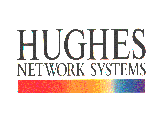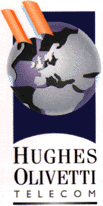

By their very nature, World Land Speed Record attempts must take place far from areas of population. Communications become very difficult - not only for telephone/fax, but also for data. With the prospect of operating in Jordan coming up, the ThrustSSC looked for a means of establishing reliable telecommunications with the UK from their desert base. Hughes Network Systems and Hughes Olivetti Telecom provided the ideal solution - a satellite link.
The need for telephones and fax machines is straightforward - not only do the team need to contact their families back in the UK, but they also need to contact sponsors, the media and suppliers, often at short notice. It may sometimes be useful to be able to discuss a part of the car with the supplying sponsor while working next to the car - and hence the telephone line has been made accessible outside using a normal domestic cordless telephone.
The data link has a number of uses. At the personal level, it allows the team to keep contact with home via email. It also enables email contact with the project's sponsors and those members of the media with email capability. Most important of all is the ability to send telemetry data from the car to the University of Swansea and DERA Chertsey for analysis, receiving the results by the same means. The biggest consumer of satellite capacity, though, is the Web Site - the link is used to load all the reports, the photos, and the audio clips for the Global Radio section. In a similar fashion to the cordless telephone, the satellite link into the Pit Station's computer network is extended out across the desert using wireless network transmitters.
In Jordan and England the team uses a 6ft dish aligned with the Eutelat II F4 satellite 42,000km high in geostationary orbit at longitude 7E. The satellite link gives the team two telephone lines and a data connection to Hughes' hub at Brooklands Park near Potters Bar. At the hub the voice and fax connections are passed onto the UK telephone network, while an ISDN line carries the data to Digital's network centre in Newbury where it joins the same segment of the Internet as the Web Site. The 'remote' end of the satellite link is controlled through a Personal Earth Station in the Pit Station's communications room, attached to which are the Vocality CODECs for the telephones and the computer network for the data.
In America the dish is lined up on Galaxy IV at 99W - Eutelsat II being below the horizon. The two phone lines link onto Hughes' exchange in Germanstown, Maryland, while the data reaches the Web Site through Hughes' DirecPC service onto the Internet backbone.
The satellite link has proved invaluable on a number of occasions. On the first high-speed trials in Jordan, a problem was found with the Non-Return Valves in the car's fuel system. Using the telephone, a replacement part was identified and drawings of it received by fax. Mechanical Designer Glynne Bowsher used the drawings to design the mountings, then faxed those designs to the UK for machining. Within 3 days of identifying the problem the new parts were installed and ready on the car. Such a fast turnaround could not have been achieved without the satellite.
The link also came into its own on one occasion when data sheets were needed for an overheating power regulator. The required information was quickly found on the manufacturer's Web Site and the problem resolved very easily - from the middle of the Jafr Desert.
Perhaps the importance of the satellite link is revealed by the observation that the team never feels too far from home. The value of that cannot be underestimated.
More information about Hughes Network Systems can be found on their Web Site at http://www.hns.com.
 |
 |
 |
||
| Sponsored by | This site best viewed with Microsoft Internet Explorer 3 | |||